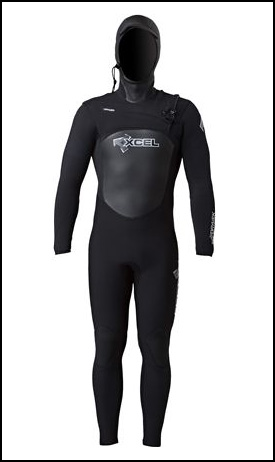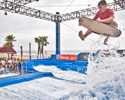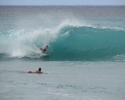Surf Wear
What To Wear While Surfing
The gear you where while surfing will allow you to stay comfortable, warm and rash free. There are a wide range of options available depending on the water temperature.
The most important aspect of what you wear is that you are comfortable in it. We've prepared a list of options to help guide you in your search.
A special thanks to Swell.com for the images. All of the items featured in this article (or updated versions) are available for sale in their online surf shop.
What To Wear While Surfing
Trunkin' It

Board Shorts - The standard surfing gear, board shorts come in a wide range of options. Gone are the days of uncomfortable, bulky bathing suits that cause rashes.
Current board short technology incorporates quick drying, light weight and stretchable fabrics. The great part about a nice pair of board shorts is that you can let them dry and walk around in them like they're sho
rts. Sometimes they are referred to as trunks, boardies or just shorts.
 Rash Guard - These stretchy shirts help protect you from the sun and rashes. Some people surf without one, but if you're prone to getting a rash from the wax on your board, its much easier just to wear one.
Rash Guard - These stretchy shirts help protect you from the sun and rashes. Some people surf without one, but if you're prone to getting a rash from the wax on your board, its much easier just to wear one.
If you don't want to shell out the cash for a rash guard, you can also wear a t-shirt. Cotton isn't the best material, but can work in a crunch. Synthetic materials tend to work much better.
 Neoprene Vest - This is a great option when you are a bit cold in your
Neoprene Vest - This is a great option when you are a bit cold in your  boardies. A vest can also be especially helpful if its windy and your upper body is getting cold sitting outside of the water. Vest are un-inhibiting on your shoulders and arms but help keep warmth in near your heart.
boardies. A vest can also be especially helpful if its windy and your upper body is getting cold sitting outside of the water. Vest are un-inhibiting on your shoulders and arms but help keep warmth in near your heart.
Neoprene vests can also serve to protect you from getting a rash. Additionally, if it is ever really cold, you can wear a vest under your regular wetsuit for some extra warmth. They are inexpensive ($30-50) and useful in many situations. Because of this, we at SurfScience.com strongly recommend the vest.
 Neoprene Jacket - The neoprene jacket is kind of like wearing half of a wetsuit. It can be worn with boardshorts or even on top of a long-john. Neoprene jackets are a good option for SUPing as well. They help protect you from wind chill whether you're dry or wet.
Neoprene Jacket - The neoprene jacket is kind of like wearing half of a wetsuit. It can be worn with boardshorts or even on top of a long-john. Neoprene jackets are a good option for SUPing as well. They help protect you from wind chill whether you're dry or wet.
One of the benefits of the neoprene jacket over a wetsuit is that it doesn't require a zipper for entry. This can make is a bit more comfortable.
Spring Suits
 There are a few different wetsuit variations that we consider spring suits. Which one you choose to wear is a matter of preference. The reason they are referred to as spring suits because it is usually worn in the spring or fall when the water is colder than the summer, but not quite cold enough to wear a full suit yet.
There are a few different wetsuit variations that we consider spring suits. Which one you choose to wear is a matter of preference. The reason they are referred to as spring suits because it is usually worn in the spring or fall when the water is colder than the summer, but not quite cold enough to wear a full suit yet.
Spring suits usually come in a thickness of 2:1 which means 2mm of neoprene in the chest and 1mm in the arms and legs.
 Spring Suit - The traditional spring suit is a full body suit with short legs and short arms. These suits work great for cool days because they keep you warm but place limited restriction on your limbs. Some surfers don't like to wear short leg spring suits because of the length of the legs. They sit above the knee which is ideal for warmth but not necessarily for style.
Spring Suit - The traditional spring suit is a full body suit with short legs and short arms. These suits work great for cool days because they keep you warm but place limited restriction on your limbs. Some surfers don't like to wear short leg spring suits because of the length of the legs. They sit above the knee which is ideal for warmth but not necessarily for style.
Long Arm Spring Suit - Just like the spring suit except with long arms. This suit works great when it is a bit windy out. The long sleeves on the top will keep your upper body warm while the short legs will provide more mobility that a full suit.
 Short John - The short john is a suit with short arms and a sleeveless top. Its sort of like wearing shorts and a tank top. A modification of the Long John suit, short johns are popular with longboarders because they provide full mobility of the arms for paddling. (See Long John below for additional information)
Short John - The short john is a suit with short arms and a sleeveless top. Its sort of like wearing shorts and a tank top. A modification of the Long John suit, short johns are popular with longboarders because they provide full mobility of the arms for paddling. (See Long John below for additional information)
 Long John - Basically a pair of neoprene overalls, the long john combines long legs with a sleeveless top. This model of wetsuit is popular with longboarders. It gives full freedom to the arms for paddling, but keeps their chest and legs warm.
Long John - Basically a pair of neoprene overalls, the long john combines long legs with a sleeveless top. This model of wetsuit is popular with longboarders. It gives full freedom to the arms for paddling, but keeps their chest and legs warm.
The long legs also give the benefit of knee pads which are helpful for knee paddling.
 Short Arm Full Suit - (Sometimes called long leg spring suits) The short arm full suit is a great option if you don't like how short the legs on spring suits are. Aside from Kelly Slater, most people don't look cool in spring suits. The short arm suit is a nice alternative. They give the surfer more mobility in the arms and shoulders while keeping your legs warm.
Short Arm Full Suit - (Sometimes called long leg spring suits) The short arm full suit is a great option if you don't like how short the legs on spring suits are. Aside from Kelly Slater, most people don't look cool in spring suits. The short arm suit is a nice alternative. They give the surfer more mobility in the arms and shoulders while keeping your legs warm.
Short arm full suits tend to be popular with high performance shortboarders. The first reason why is that it keeps your leg muscles warm. This is especially necessary in shortboarding to avoid pulling a muscle during motions which require stretching and bending. The other benefit to the long legs is the padding on the knees. This is good for your board because the padding protects it from dings if you hit the board with your knee.
 Full Suits
Full Suits
 Full Suit - The full suit is the standard wetsuit. Complete with long legs and long arms. The two main types of full suits you will see are 3:2 & 4:3. Those numbers mean the thickness of the neoprene. The first number is the thickness in the chest and the second is the thickness in the arms and legs. So a 4:3 is thicker than a 3:2 and will therefore keep you warmer.
Full Suit - The full suit is the standard wetsuit. Complete with long legs and long arms. The two main types of full suits you will see are 3:2 & 4:3. Those numbers mean the thickness of the neoprene. The first number is the thickness in the chest and the second is the thickness in the arms and legs. So a 4:3 is thicker than a 3:2 and will therefore keep you warmer.
 Hooded Full Suit - This is the suit you wear when it is really really cold. The hooded suit keeps your whole body and head warm. Most surfers do not have a hooded suit as their primary suit becau
Hooded Full Suit - This is the suit you wear when it is really really cold. The hooded suit keeps your whole body and head warm. Most surfers do not have a hooded suit as their primary suit becau se it would be too warm for most of the year. Instead they use another suit and only pull out the hooded one when it is really cold. Of course, if you live somewhere really far north or south... maybe a hooded suit is your go to!
se it would be too warm for most of the year. Instead they use another suit and only pull out the hooded one when it is really cold. Of course, if you live somewhere really far north or south... maybe a hooded suit is your go to!
Dry Suit - These are not common for surfers to wear. A wetsuit works by getting wet and then trapping a thin layer of water against your body which then heats up and keeps you warm. A dry suit, however, is designed to keep you dry. To stay warm, you wear clothes like wool thermals underneath it. While you will probably never wear one, its good to know what they are.
Accessories
 Booties - These are worn on your feet to keep your toes warm. They can also be used to protect you from sharp rocks, reefs or sea urchins. They come in a few varieties, but all serve the same basic purpose.
Booties - These are worn on your feet to keep your toes warm. They can also be used to protect you from sharp rocks, reefs or sea urchins. They come in a few varieties, but all serve the same basic purpose.
Reef Socks - Reef socks are designed to protect your feet from sharp rocks or reefs while you are surfing.
 Gloves - These keep your hands warm. It is not much fun when your hands go numb while you're surfing. You can't paddle well, you can't hold your board and its really tough to get out of your wetsuit once you're on land.
Gloves - These keep your hands warm. It is not much fun when your hands go numb while you're surfing. You can't paddle well, you can't hold your board and its really tough to get out of your wetsuit once you're on land.
 Hood - There are a few different hood models designed to protect you from getting an ice cream headache. Some go all the way down your neck while others just cover your head. Some surfers don't like surfing in hoods because of the constricting feeling. When the water is really cold, however, its worth it!
Hood - There are a few different hood models designed to protect you from getting an ice cream headache. Some go all the way down your neck while others just cover your head. Some surfers don't like surfing in hoods because of the constricting feeling. When the water is really cold, however, its worth it!
Hat - There are a few types of hats that you can wear while surfing to protect you from the sun. They help prevent sunburns as well as damage to your eyes. The simplest is just a regular baseball cap. You might loose it in the water, but most of the time it stays close by. There are also hats with wide brims or floppy wrap around brims. Some even strap to your head. Its all a matter of preference.
Helmet - These keep your head in one piece when you wipe out. Helmets have never been popular amongst surfers. Even though they are now widely accepted in BMX, snowboarding, skiing, skateboarding, etc, surfers just don't like them. Whether or not they are cool is up for debate - one one side, they aren't very cool, on the other, Tom Carroll wore one, close call.











5 Comments